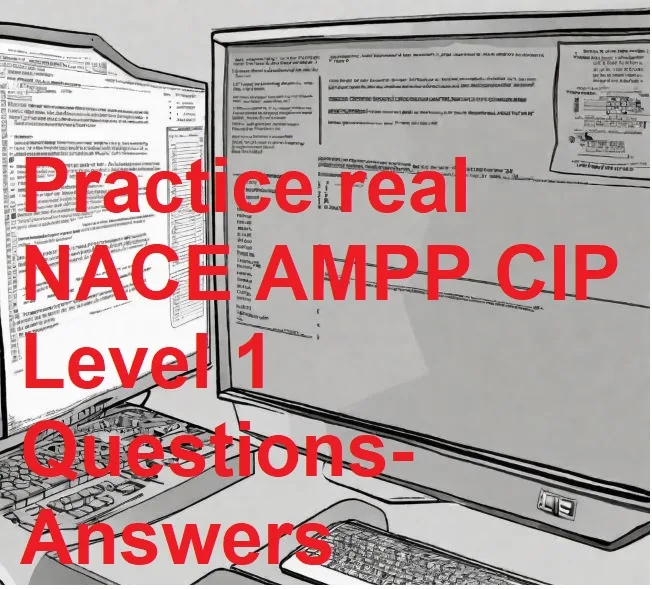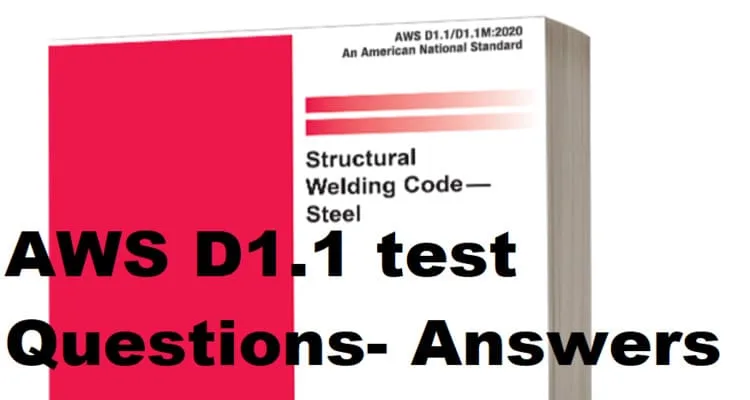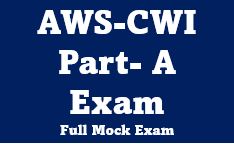NACE CIP Level 1 Exam Questions
Practice real NACE AMPP CIP Level 1 Questions & Pass the exam guaranteed @WWW.CWINDTEXAMS.COM

- Who is responsible for developing the project specification?
- A) The specifier or engineer
- B) The contractor
- C) The inspector
- D) The asset owner
- What is the purpose of a work plan created by the contractor?
- A) To outline the inspector’s responsibilities
- B) To detail the inspection test plan
- C) To fulfill the specification’s requirements
- D) To document the project’s progress
- Where you can practice 500+ real NACE AMPP CIP Level 1 theory exam CBT questions & pass the exam guaranteed?
- www.cwindtexams.com
- What is the purpose of an Inspection Test Plan (ITP)?
- A) To outline the inspection and testing requirements
- B) To provide transparency around the inspector’s responsibilities
- C) To communicate the project’s progress
- D) To document the completion of work
- What does a comprehensive Inspection Test Plan (ITP) ensure?
- A) That all specified procedures have been followed
- B) That the contractor has developed a work plan
- C) That the project specification is lengthy and complex
- D) That the inspector’s role is adequately prepared
- What benefits do Inspection Test Plans (ITPs) provide?
- A) Enable adequate preparation for the inspector’s role
- B) Act as a communication tool between various stakeholders on a project
- C) Document the coating project’s progress
- D) Ensure that the coating system is installed as specified
- What does an Inspection Test Plan (ITP) convert into a practical document for use in the field?
- A) Quality requirements in the project specification
- B) Inspection and testing requirements for a specific process
- C) Techniques, equipment, materials, and safety measures
- D) Procedures for each stage of the installation process
- How can an inspector utilize an Inspection Test Plan (ITP) prior to each work shift?
- A) To prepare for the required inspection tasks
- B) To communicate with QA and QC personnel
- C) To track the progress of the project
- D) To provide evidence of the quality of the completed work
- What role do Inspection Test Plans (ITPs) play in communication between stakeholders?
- A) Ensuring the inspector, contractor, and asset owner have the same information
- B) Documenting the completion of work
- C) Tracking the progress of the project
- D) Providing evidence of the quality of the completed work
- What confidence do Inspection Test Plans (ITPs) provide in the completed work?
- A) Provide QA inspector and asset owner confidence
- B) Provide transparency around the inspector’s responsibilities
- C) Ensure that the coating system is installed as specified
- D) Document the project’s progress
- Practice real NACE AMPP CIP Level 1 Questions & Pass the exam guaranteed
- What is the primary function of an Inspection Test Plan (ITP) as a communication tool?
- A) To ensure that all stakeholders have the same information
- B) To track the progress of the project
- C) To provide transparency around the inspector’s responsibilities
- D) To document the completion of work
- What is the purpose of calculating the average of multiple gauge readings in a coating project?
- A) To determine the highest gauge reading
- B) To identify outliers in the readings
- C) To obtain a representative value for the measured parameter
- D) To calculate the total thickness of the coating
- Why are coating specifications often provided as a range rather than a single value?
- A) To make the specifications more complicated
- B) To confuse the applicator
- C) To allow for tolerance in achieving the required thickness
- D) To simplify the inspection process
- According to SSPC-PA 2, Restriction Level 3, what is the acceptable range for spot measurements in terms of thickness?
- A) Between 50% and 70% of the specified thickness
- B) Between 80% and 120% of the specified thickness
- C) Between 100% and 150% of the specified thickness
- D) Between 90% and 110% of the specified thickness
- What is the purpose of understanding volume solids in coatings?
- A) To determine the weight of the coating
- B) To calculate the wet film thickness
- C) To predict the final dry film thickness
- D) To identify the type of solvent used in the coating
- What is wet film thickness?
- A) The thickness of the coating after curing
- B) The thickness of the coating immediately after application
- C) The thickness of the coating before solvent evaporation
- D) The thickness of the coating measured in micrometers
- Why is it important for inspectors to understand the relationship between wet and dry film thickness?
- A) To ensure proper application of the coating
- B) To calculate the volume solids of the coating
- C) To estimate the weight of the coating
- D) To identify defects in the coating
- What is the primary concern of inspectors regarding coating thickness?
- A) Achieving the thinnest possible coating
- B) Ensuring compliance with specified thickness requirements
- C) Maximizing the coating’s resistance to corrosion
- D) Minimizing the cost of the coating application
- Why do coating manufacturers not always provide wet film thickness values in their instructions?
- A) To increase the complexity of the coating process
- B) Because wet film thickness varies depending on application conditions
- C) To confuse inspectors
- D) Because wet film thickness is irrelevant to the coating’s performance
- How can an inspector calculate the acceptable range of spot checks based on specified thickness requirements?
- A) By dividing the specified thickness by the volume solids percentage
- B) By multiplying the specified thickness by the allowable tolerance percentages
- C) By subtracting the volume solids percentage from the specified thickness
- D) By adding the volume solids percentage to the specified thickness
- What role does the contractor play in ensuring compliance with coating thickness requirements?
- A) Ensuring accurate measurement of wet film thickness
- B) Applying the coating to the specified wet film thickness
- C) Determining the acceptable tolerance for spot measurements
- D) Calculating the average dry film thickness achieved
- What are digital dew point meters capable of measuring simultaneously?
- A) Air temperature only
- B) Relative humidity only
- C) Air temperature, relative humidity, and dew point
- D) Surface temperature and wind speed
- What term is commonly used to refer to instruments that can measure multiple environmental conditions?
- A) Magnetic thermometers
- B) Dial type thermometers
- C) Single-purpose instruments
- D) Digital all-in-one devices
- What abbreviation is used to represent surface temperature on digital instrument displays?
- A) RH%
- B) Ta
- C) Ts
- D) Td
- Why is it important to review the manufacturer’s user manual when using digital instruments?
- A) To find shortcuts for measurements
- B) To understand the display abbreviations and symbols
- C) To determine the battery life of the instrument
- D) To learn about the history of the instrument
- What is the potential consequence of surface temperature being above the required range during coating application?
- A) Increase in coating viscosity
- B) Reduction in pot life
- C) Formation of moisture on the substrate
- D) Improper curing of the coating film
- Which type of thermometer is specifically designed to be used on magnetic or horizontal surfaces?
- A) Dial type thermometer
- B) Digital infrared thermometer
- C) Wet bulb thermometer
- D) Magnetic surface contact thermometer
- What holds the magnetic surface contact thermometer to the surface being measured?
- A) Batteries
- B) High-temperature magnets
- C) Drafts
- D) Infrared sensors
- Which standard describes the use of a Magnetic Surface Contact Thermometer?
- A) ASTM D3276 Standard Guide for Painting Inspectors (Metal Substrates)
- B) ASTM D3359 Standard Test Methods for Measuring Adhesion by Tape Test
- C) ASTM D4541 Standard Test Method for Pull-Off Strength of Coatings Using Portable Adhesion Testers
- D) ASTM D610 Standard Test Method for Evaluating Degree of Rusting on Painted Steel Surfaces
Practice real NACE AMPP CIP Level 1 Questions & Pass the exam guaranteed
Answers
- C) The specifier or engineer
- C) To fulfill the specification’s requirements
- A) To outline the inspection and testing requirements
- A) That all specified procedures have been followed
- B) Enable adequate preparation for the inspector’s role
- A) Quality requirements in the project specification
- A) To prepare for the required inspection tasks
- A) Ensuring the inspector, contractor, and asset owner have the same information
- A) Provide QA inspector and asset owner confidence
- C) To provide transparency around the inspector’s responsibilities
- C) To obtain a representative value for the measured parameter
- C) To allow for tolerance in achieving the required thickness
- B) Between 80% and 120% of the specified thickness
- C) To predict the final dry film thickness
- B) The thickness of the coating immediately after application
- A) To ensure proper application of the coating
- B) Ensuring compliance with specified thickness requirements
- B) Because wet film thickness varies depending on application conditions
- B) By multiplying the specified thickness by the allowable tolerance percentages
- B) Applying the coating to the specified wet film thickness
- C) Air temperature, relative humidity, and dew point
- D) Digital all-in-one devices
- C) Ts
- B) To understand the display abbreviations and symbols
- B) Reduction in pot life
- D) Magnetic surface contact thermometer
- B) High-temperature magnets
- A) ASTM D3276 Standard Guide for Painting Inspectors (Metal Substrates)







